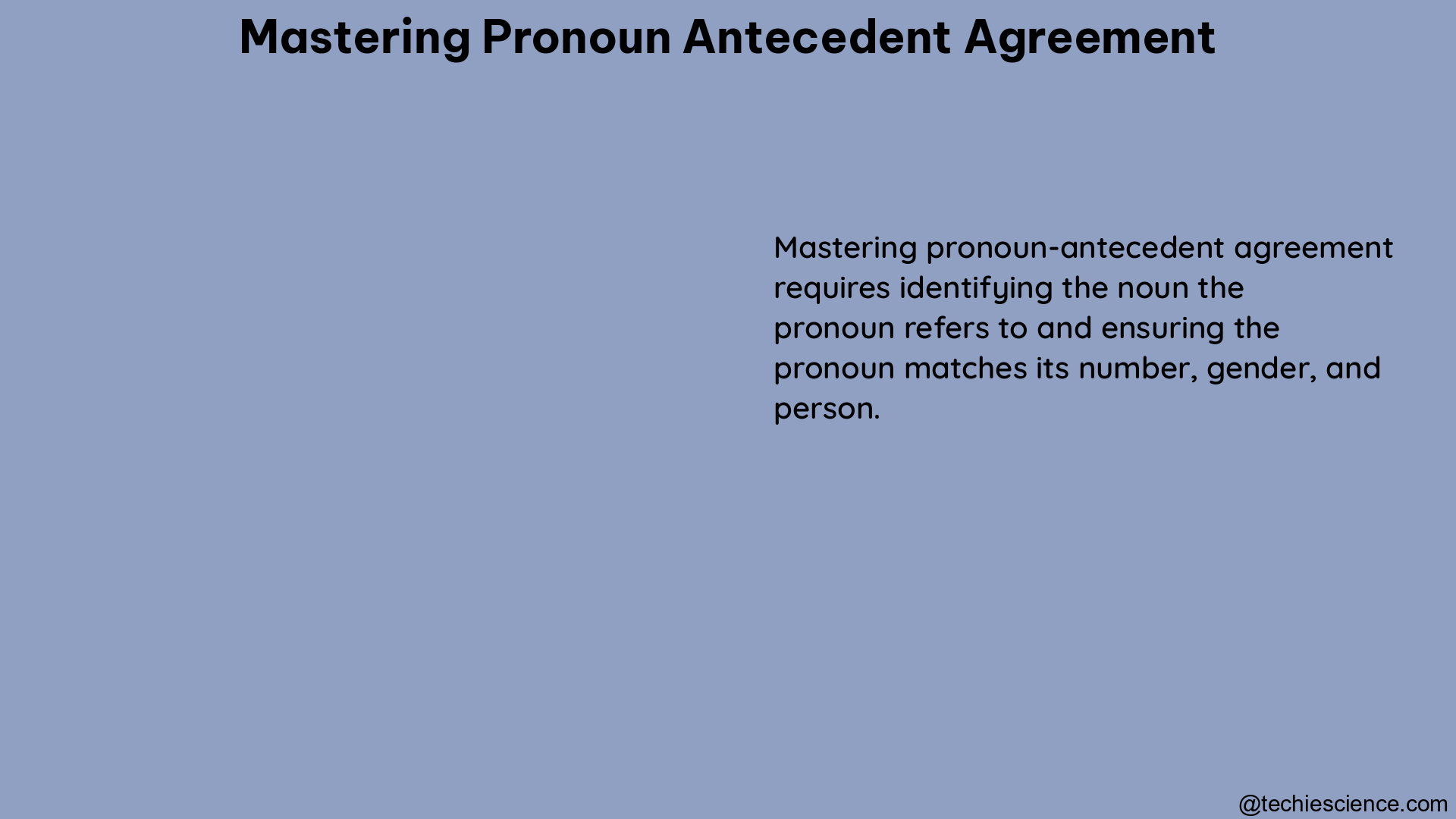Pronoun-antecedent agreement is a fundamental aspect of English grammar that requires careful attention to ensure clear and coherent communication. This comprehensive guide delves into the advanced details and nuances of this concept, providing you with the knowledge and tools to master it effectively.
Definition of Antecedent
An antecedent is the noun or phrase that a pronoun refers to in a sentence. It is the “thing that came before” the pronoun. Understanding the relationship between the antecedent and the pronoun is crucial for maintaining grammatical accuracy and clarity in your writing.
Pronoun-Antecedent Agreement

Pronouns must agree with their antecedents in number (singular or plural). This means that if the antecedent is a singular noun, the pronoun should also be singular, and vice versa. Maintaining this agreement is essential for creating coherent and unambiguous sentences.
Identifying the Antecedent
Identifying the antecedent can be a challenging task, especially when multiple nouns are present in a sentence or when the pronoun is located far from its antecedent. To identify the antecedent, carefully read the sentence and determine the noun that the pronoun logically refers to. This process may require close attention and critical thinking to ensure accurate identification.
Plural and Singular Pronouns
Ensuring the correct use of plural and singular pronouns is a key aspect of pronoun-antecedent agreement. Plural pronouns, such as “they,” “them,” and “their,” should be used with plural antecedents, while singular pronouns, such as “he,” “she,” and “it,” should be used with singular antecedents.
Gendered Pronouns
Gendered pronouns, such as “he” and “she,” should be used correctly based on the gender of the antecedent. However, it’s important to note that the SAT does not typically ask you to choose between gendered pronouns and the non-gendered singular pronoun “they” when referring to a single person.
Advanced Examples
- Singular Antecedent:
- Jillian rode her bike to the grocery store. She bought some garlic and a spoon.
-
In this example, “Jillian” is the singular antecedent, and “she” is the pronoun that agrees with it in number and gender.
-
Plural Antecedent:
- The monkeys threw snowballs, but they had crummy aim.
-
Here, “monkeys” is the plural antecedent, and “they” is the plural pronoun that agrees with it.
-
Ambiguous Antecedent:
- The survival of the orangutan is threatened by the destruction of its habitat.
- In this case, “orangutan” is the antecedent, and “its” is the possessive pronoun that agrees with it.
Tips for Mastering Pronoun-Antecedent Agreement
- Read Carefully: Identify the antecedent by reading the sentence carefully, especially when multiple nouns are present.
- Plug in the Antecedent: If unsure about the antecedent, try replacing the pronoun with the antecedent to ensure the sentence still makes sense.
- Avoid Ambiguity: Use gender-neutral language and avoid ambiguous pronouns to ensure clarity in your writing.
Advanced Techniques for Pronoun-Antecedent Agreement
Collective Nouns
Collective nouns, such as “team,” “family,” and “group,” can present a unique challenge when it comes to pronoun-antecedent agreement. These nouns can be treated as either singular or plural, depending on the context and the intended meaning. When using a collective noun as the antecedent, carefully consider whether a singular or plural pronoun is more appropriate.
Indefinite Pronouns
Indefinite pronouns, such as “someone,” “anyone,” and “everyone,” can also pose challenges for pronoun-antecedent agreement. These pronouns do not have a clear, specific antecedent, and the choice of pronoun can depend on the context and the intended meaning. When using an indefinite pronoun, be mindful of the number and gender implications and choose the appropriate pronoun accordingly.
Compound Antecedents
When the antecedent is a compound noun, such as “John and Mary” or “the dog and the cat,” the pronoun used should agree with the combined number of the antecedents. If the antecedents are both singular, the pronoun should be singular; if the antecedents are both plural, the pronoun should be plural.
Pronoun Placement
The placement of the pronoun in relation to its antecedent can also affect pronoun-antecedent agreement. When the pronoun is located close to the antecedent, the agreement is typically more straightforward. However, when the pronoun is placed further away from the antecedent, it can be more challenging to maintain the correct agreement.
Practice and Resources
Mastering pronoun-antecedent agreement requires consistent practice and exposure to a variety of examples. Here are some resources to help you further develop your skills:
- Khan Academy – Pronoun-Antecedent Agreement (Practice)
-
https://www.khanacademy.org/humanities/grammar/syntax-conventions-of-standard-english/subject-verb-agreement-and-pronoun-antecedent-agreement/e/pronoun-antecedent-agreement
-
Khan Academy – Pronoun-Antecedent Agreement (Video)
-
Khan Academy – Grammar Guide: Pronoun-Antecedent Agreement
- https://www.khanacademy.org/test-prep/sat-reading-and-writing/x0d47bcec73eb6c4b:digital-sat-grammar-practice/x0d47bcec73eb6c4b:fss-pronoun-antecedent-agreement/a/fss-grammar-guide-pronoun-antecedent-agreement
By mastering the advanced concepts and techniques presented in this guide, you will be well-equipped to navigate the complexities of pronoun-antecedent agreement and elevate your writing to new heights of clarity and precision.
Reference:
- Khan Academy – Pronoun-Antecedent Agreement (Practice)
-
https://www.khanacademy.org/humanities/grammar/syntax-conventions-of-standard-english/subject-verb-agreement-and-pronoun-antecedent-agreement/e/pronoun-antecedent-agreement
-
Khan Academy – Pronoun-Antecedent Agreement (Video)
-
Khan Academy – Grammar Guide: Pronoun-Antecedent Agreement
- https://www.khanacademy.org/test-prep/sat-reading-and-writing/x0d47bcec73eb6c4b:digital-sat-grammar-practice/x0d47bcec73eb6c4b:fss-pronoun-antecedent-agreement/a/fss-grammar-guide-pronoun-antecedent-agreement

The lambdageeks.com Core SME Team is a group of experienced subject matter experts from diverse scientific and technical fields including Physics, Chemistry, Technology,Electronics & Electrical Engineering, Automotive, Mechanical Engineering. Our team collaborates to create high-quality, well-researched articles on a wide range of science and technology topics for the lambdageeks.com website.
All Our Senior SME are having more than 7 Years of experience in the respective fields . They are either Working Industry Professionals or assocaited With different Universities. Refer Our Authors Page to get to know About our Core SMEs.